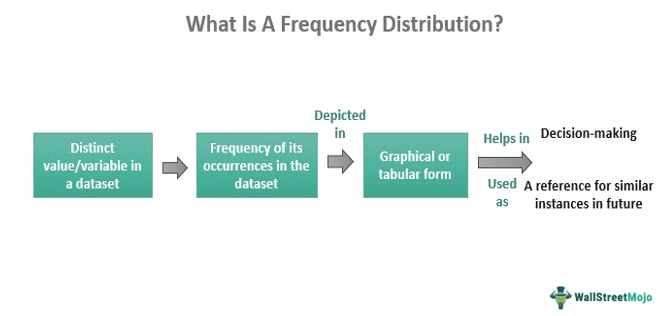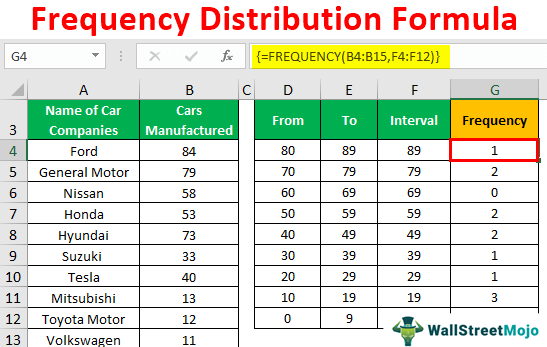Table Of Contents
Frequency Distribution Definition
Frequency distribution in statistics represents the number of times a value or an outcome repeats itself over a period of time during an event. It is featured either as a graph or table. This representation helps data analysts assess the frequency of a value over an interval during an instance and determine the possibility of such outcomes occurring again under similar circumstances.

The number of data collected and the nature of data assessment determine the format required to display the results. For example, the marks obtained by students in the form of percentile will have a histogram or pie chart to showcase the distribution of the frequencies.
Key Takeaways
- Frequency distribution in statistics refers to finding out the number of times an/a outcome/value repeats itself during an event, given the interval remains the same.
- It helps analyze the data collected to ensure it could help in effective decision-making. Plus, the results are used as a reference in similar instances in the future.
- Grouped, ungrouped, cumulative, relative, and relative cumulative distributions are some of its widely used types.
- It is an important tool in trading, though not used too often, for identifying the trends and checking price fluctuations.
Understanding Frequency Distribution
Frequency distribution is a statistical term that signifies a graphical representation of a dataset to check how many times an outcome/value occurs/ repeats itself during an event at specific intervals. For example, when a user conducts the test, this distribution indicates the possibility of the occurrence of the same outcome over a period for that event.
These results also help analyze events with similar traits to understand the possible outcomes. In addition, they let users organize the collected data and analyze it to find out the number of occurrences of one value with respect to the variable/interval over a period of time/event.
For example, Mary attends her dance classes on Sunday morning, Sunday evening, and Saturday evening. In this example, the interval or variable is the dance class with respect to which the frequency for a value (here, Sunday and Saturday) is determined. The frequency for Sunday is two, while Saturday is one in a week.
| Dance Classes | Sunday | Saturday |
| Frequency | 2 | 1 |
Types
Such distribution is done using different techniques. One of them is grouped frequency distribution. In this method, the collected data is divided into segments based on a particular range/criterion, which forms the groups. These range or class intervals help categorize data in a better way and helps represent the same more clearly in a table or graph.

Then, there is an ungrouped type of distribution where there is no grouping of data. Instead, the frequency is studied on an individual basis. For example, if one needs to record the marks obtained by one student in different subjects, this is the best way to do so.
The cumulative frequency distribution refers to the distribution plotted on the graph as per the values obtained by adding consecutive frequencies spread across different class intervals. Here, the first frequency is added to the next frequency on the list, their sum is added to the third frequency, the sum then obtained is added to the fourth frequency, and so on. The last frequency will depict the total sum of all frequencies.
Next on the list is a relative frequency distribution. As the name implies, this distribution refers to the proportion of the number of observations with respect to each category/value/interval.
Last but not least is the relative cumulative distribution combines the features of both relative and cumulative distribution techniques. It can be obtained by dividing the frequency of each category/interval/value by the total number of observations.
Formula of Frequency Distribution
For the users who want to make it easier to make such tables, frequency in the excel function can be used. Here is a frequency distribution formula for them:
Frequency(data_array,bins_array)
Here,
- Data Array is the group of numerical or non-numerical information required for the distribution. Generally, it is a group of data available for consideration.
- Bins Array is the interval created to group the data for required frequencies. For instance, if we want to make multiple frequencies for marks scored by students, it could be 0-09, 10-20, 21-30, and so on.
Examples
Let us check how to create a frequency distribution table using the formula for Excel:
Example 1

Example 2
Each home has multiple car parking facilities in a local neighborhood of Santa Clara, California. The slots numbers range within 0-5.

The frequency table created is below:

Relevance
One can use a frequency distribution table or graph to find out the progress of individual students using grouped distribution technique or to check the performance of a group as a whole using the class interval procedure, which specifies a specific range for an outcome/value to occur/repeat.
Its most appropriate use is in the financial sector, especially trading. The players in the investment industry use the frequency chart, also referred to as a point-and-figure chart. Using this chart, the floor traders identify the current market trends and the price fluctuations occurring because of the same.

